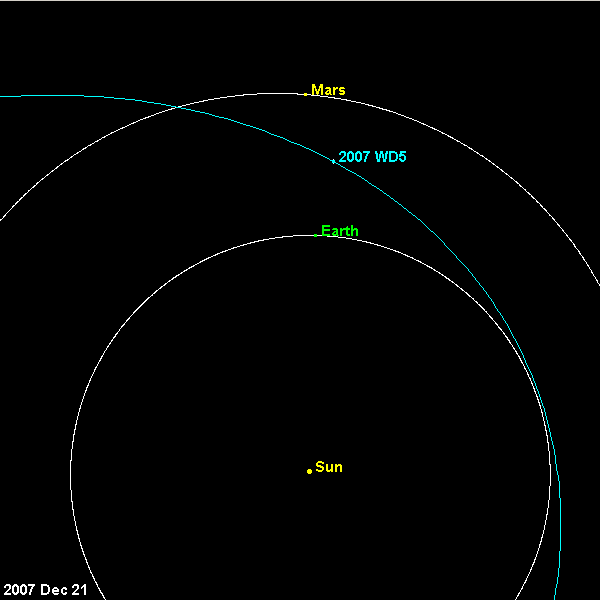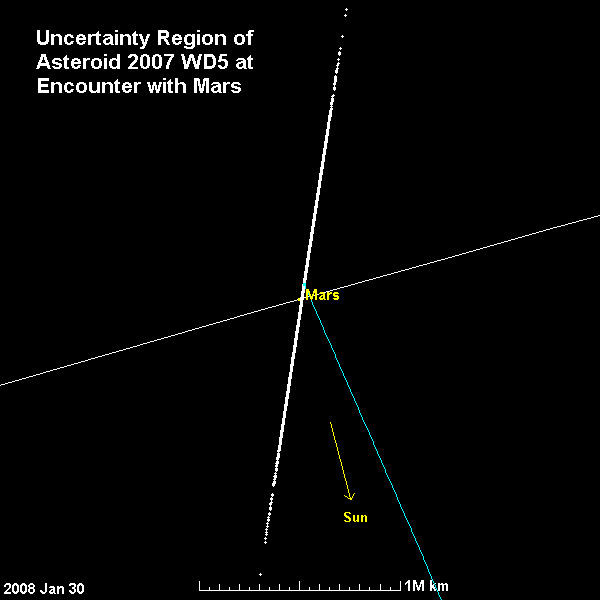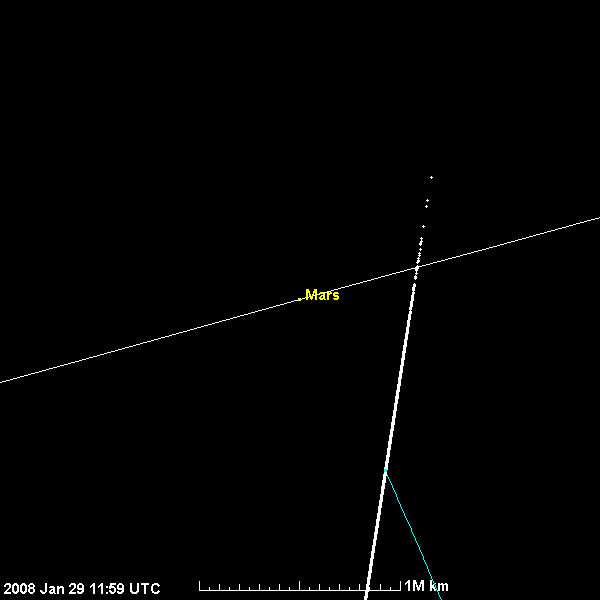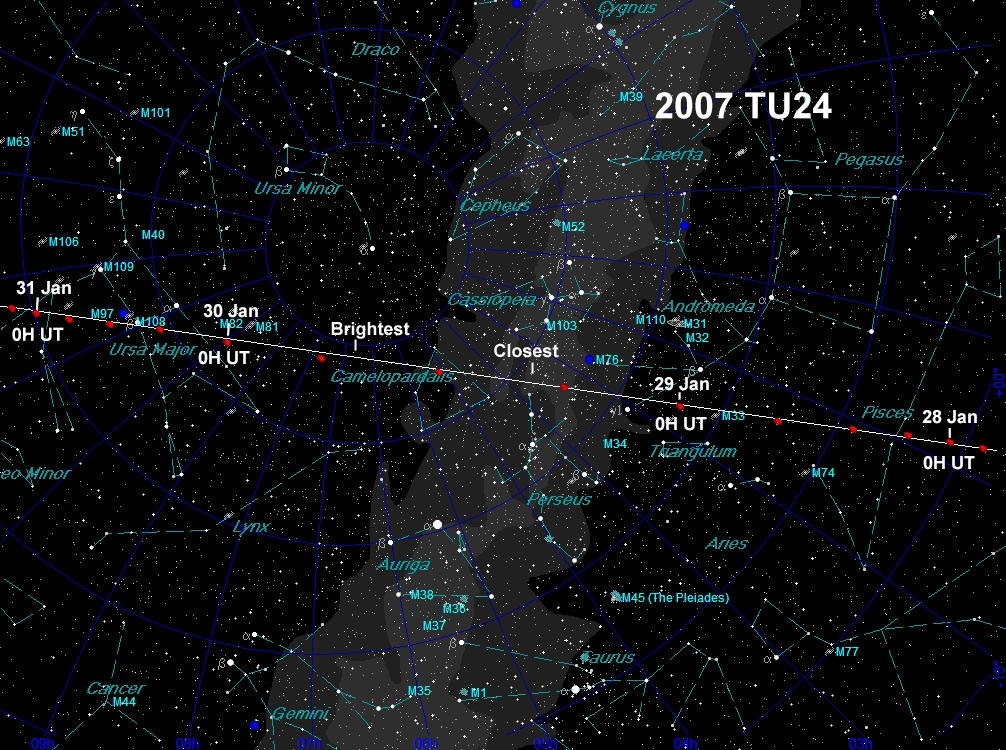|
Enigmas in Our Solar System The Asteroids |
|||
|
January 30, 2008 ..
Recently Discovered Asteroid Could Hit Mars in January Steve Chesley
and Paul Chodas
A recently discovered asteroid which passed close to the Earth in November, is now headed towards a very close passage by Mars in late January, and there is a small chance that it could hit that planet. The probability of a collision is only 1 chance in 75, but scientists are excited about the possibility. If it happens, the impact would occur on January 30, 2008 at around 10:55 UT (2:55 a.m. PST).
In the likely event that the asteroid misses Mars, it could come back to the vicinity of the Earth years or decades later, but our routine hazard monitoring shows that there is no threat of an impact with the Earth.
Large Version (600x600) Small Version (300x300) The thin white line is the orbit of Mars. The blue line traces the motion of the center of the uncertainty region, which is the most likely position of the asteroid. Designated 2007 WD5, the asteroid was discovered on Nov. 20, 2007 by the NASA-funded Catalina Sky Survey using a 1.5m telescope on Mt. Lemmon, near Tucson. The object had already passed within 7.5 million km (5 million miles) of the Earth on Nov. 1, before it was discovered. Based on its magnitude, we estimate the asteroid to be about 50 meters (160 feet) across. As the accompanying diagram shows, it has already reached the halfway point between Earth and Mars. When it closes in on Mars, it will approach from the day side, and would then be very difficult to observe from any of the spacecraft on or around Mars. Our current best estimate predicts the asteroid will miss Mars by 50,000 km, but the miss distance is highly uncertain because the asteroid's path is not known with sufficient accuracy. The uncertainty region during the Mars encounter currently extends over a million kilometers (700,000 miles) along a very slender ellipsoid only 1200 km (700 miles) wide, but the ellipsoid does intersect Mars. The zone of potential impact on the surface of Mars is approximately 800 km wide, and sweeps across the Martian equator from southwest to northeast, crossing the equator at roughly 30 deg W longitude. The MER Opportunity rover is close to the southern edge of this possible impact zone but clearly outside it. The asteroid is becoming increasingly difficult to observe, since it is receding from the Earth and the waxing Moon is approaching the same part of the sky. But it should become observable again early in January. These new measurements will lead to a significant improvement in the orbit accuracy, and we will then be able to refine the probability that the asteroid might collide with Mars. If the asteroid is indeed on a collision course, it would hit Mars with a velocity of about 13.5 km/s (8.4 miles per second), and would produce an explosion equivalent to about 3 MT of TNT. We can only speculate as to the effects of such an impact, but it would be reasonable to expect a crater nearly a kilometer across and a significant amount of dust lifted into the atmosphere. An impact
would not be unprecedented:
21 fragments of Comet Shoemaker-Levy 9 impacted
Jupiter in July, 1994.
Those impacts were predicted with near certainty
almost a year before the
impact. But, with a 1-in-75 chance, this
asteroid's possible impact with
Mars is far from certain.
|
|||
|
January 29, 2008 ..
Near-Earth
Asteroid 2007
TU24 to Pass Close to Earth
Near-Earth Asteroid 2007 TU24 to Pass Close to Earth on Jan. 29 - Should be Observable with Modest Sized TelescopesDon YeomansNASA/JPL Near-Earth Object Program Office January 22, 2008 Asteroid 2007 TU24, discovered by the Catalina Sky Survey on October 11, 2007 will closely approach the Earth to within 1.4 lunar distances (334,000 miles) on 2008 Jan. 29 08:33 UT. This object, between 150 and 600 meters in diameter, will reach an approximate apparent magnitude 10.3 on Jan. 29-30 before quickly becoming fainter as it moves further from Earth. For a brief time the asteroid will be observable in dark and clear skies with amateur telescopes of 3 inch apertures or larger. For an interactive illustration of this object's orbit see: http://ssd.jpl.nasa.gov/sbdb.cgi?sstr=2007+TU24&orb=1 The illustration below is courtesy of amateur astronomer Dr. Dale Ireland from Silverdale, WA. The illustration shows the asteroid's track on the sky for 3 days near the time of the close Earth approach as seen from the city of Philadelphia. Since the object's parallax will be a significant fraction of a degree, observers are encouraged to use our on-line Horizons ephemeris generation service for their specific locations. These personalized ephemeris tables can be generated at: http://ssd.jpl.nasa.gov/horizons.cgi?find_body=1&body_group=sb&sstr=2007%20TU24 Given the estimated number of near-Earth asteroids of this size (about 7,000 discovered and undiscovered objects), an object of this size would be expected to pass this close to Earth, on average, about every 5 years or so. The average interval between actual Earth impacts for an object of this size would be about 37,000 years. For the January 29th encounter, near Earth asteroid 2007 TU24 has no chance of hitting, or affecting, Earth. 2007 TU24 will be the closest currently known approach by a potentially hazardous asteroid of this size or larger until 2027. Plans have been made for the Goldstone planetary radar to observe this object Jan 23-24 and for the Arecibo radar to observe it Jan 27-28 and then Feb 1-4. High resolution radar imaging is expected, which may permit later 3-D shape reconstruction. Updates: |
|||
| FAIR USE NOTICE: This page contains copyrighted material the use of which has not been specifically authorized by the copyright owner. Pegasus Research Consortium distributes this material without profit to those who have expressed a prior interest in receiving the included information for research and educational purposes. We believe this constitutes a fair use of any such copyrighted material as provided for in 17 U.S.C § 107. If you wish to use copyrighted material from this site for purposes of your own that go beyond fair use, you must obtain permission from the copyright owner. | |||
|
|




